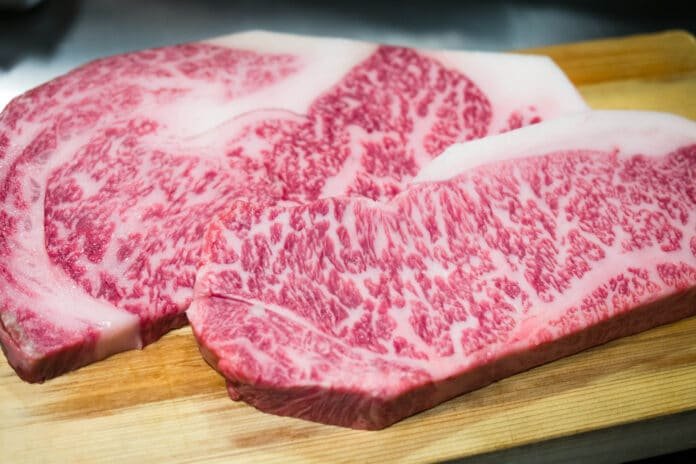
Japanese Wagyu beef is one of the most prized proteins in the culinary world and is deemed as luxurious as caviar and black truffles. The stunning marbling of fat, tantalising texture and umami-rich wagyu is what all steak lovers dream of eating. As a result, the sought after meat is used across Michelin starred restaurants across the world and has become one of Japan’s most prized ingredients. However, there is still a lot of confusion and questions as to what Wagyu actually is and where it comes from. So let’s get into everything you will ever need to know about Japan’s famous wagyu beef.
Table of Contents
What is Wagyu?
Firstly, wagyu is a type of cattle, which in Japan, is separated into four different breeds: the black, brown, shorthorn, and polled. This includes cattle produced in Japan as well as other countries such as Australia and the United States. When people think of Wagyu, the thought of Kobe beef springs to mind. While this is correct, Japanese Wagyu is not Kobe beef, but simply Kobe beef is a type of Wagyu from a particular black cattle strain grown in Kobe City.
Secondly, what makes Wagyu so unique is the inter-muscular fat that breaks the growth of connective tissue networks within the meat. The fat gets in the way of the connective tissue expanding and connecting with itself meaning weak muscles and extremely tender meat. These fats create a unique smell, aroma and taste as the fatty acid composition breaks down into powerful odourants. In addition, wagyu has a high proportion of unsaturated fats relative to other fatty acids and gram-for-gram it makes it healthier than other more saturated animal fats.
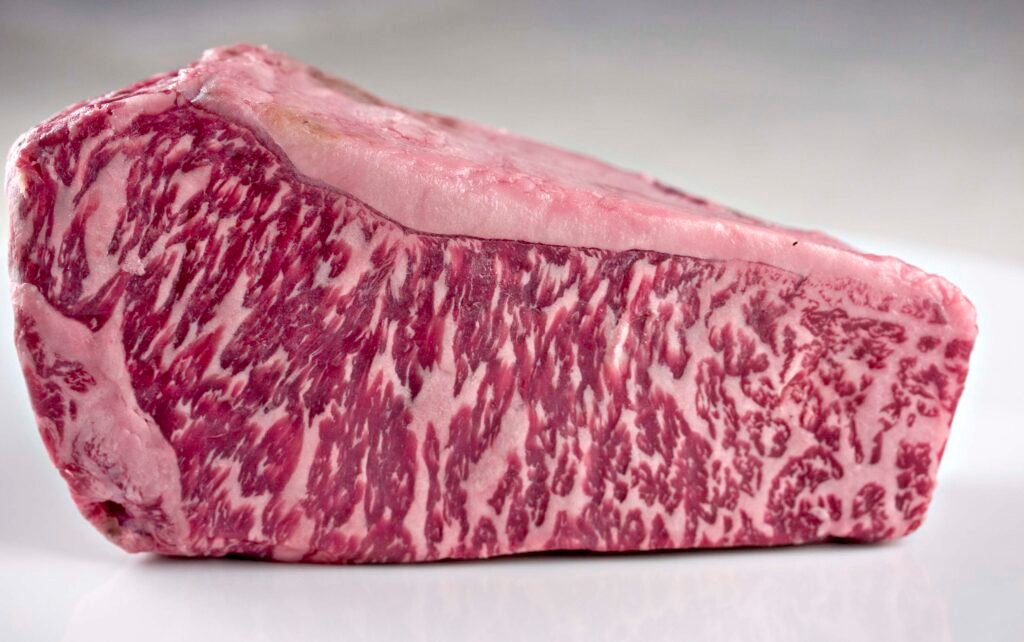
History of Japanese Wagyu
Historians recorded that cattle, pigs, and chickens were in Japan between 500BC AND 300AD. The timing coincided with the introduction of rice cultivation. As a result, people used cattle for mining, forestry, transportation, and rice farming. These cattle migrated from North China, as well as Mongolia and Siberia. Following this, Buddhist leaders banned the eating of the flesh of animals, making them work-based animals. Their worth became their physical prowess and people decided to breed on maternal traits. During the Meji Restoration era, in 1867, the government lifted this ban on eating meat. From there, cattle became sought after for their milk and meat, leading to a shipment of cattle from Kobe to Yokohama. For that reason, this beef became popular and gained the name Kobe Beef.
Due to the surge of demand for milk and beef, Japan decided they needed to increase the yield with large and improved breeds of cattle. Yet, compared to other regions in the world, Japan is small, especially with the land available to raise cattle. To compensate for the lack of supply of beef, Japan started to crossbreed native cattle with imported breeds. These included Braunvieh and Simmental cattle from Switzerland, Ayrshire, Devon, and Shorthorn cattle from the United Kingdom, and Holstein cattle from Germany and the Netherlands. This helped increase the size and yield meeting the demand of the public.
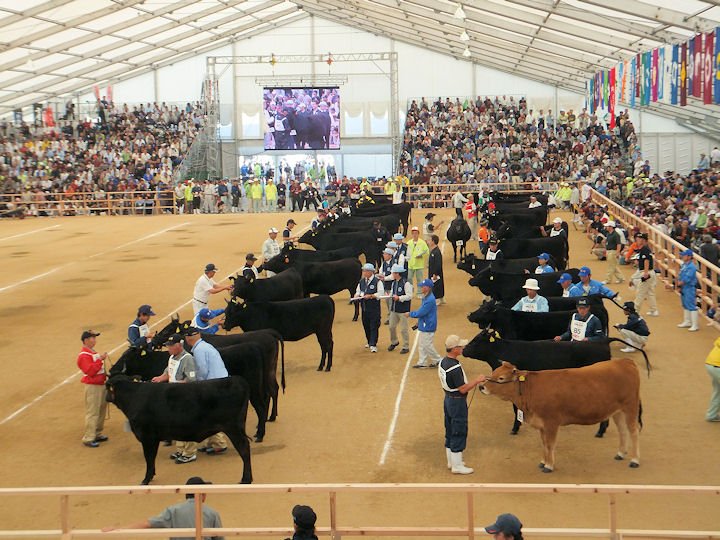
A decline in quality
However, as years passed, the quality of meat declined which prompted Japan to stop crossbreeding and start to intra-breed cattle. One of the original Japanese cattle breeds, Mishima, is bred on Mishima Island in Yamaguchi prefecture. People considered it to improve meat quality when crossed with other breeds and was thus a key component in the intra-breeding process. The result was the birth of the Japanese black breed in 1944, the leading cattle breed of Wagyu. After World War 2, farmers started to focus on raising this black breed for marbled beef production. The name Wagyu includes the Japanese black breed cattle as well as crossbred Japanese black cattle produced in other countries. The black breed comprises over 90% of Wagyu raised in Japan, highlighting its importance in the beef market.
Furthermore, in 1991, the Uruguay Round (multilateral trade negotiations) saw an upsurge in imported products such as beef, which severely affected the Japanese beef market. Leaner and less fat marbled beef was available cheaper than Japanese beef putting farmers at risk. This led to a shift in the perception of beef as Japanese beef farmers and the government aimed for increasingly marbled beef and improving the quality rather than the amount.
How is Japanese Wagyu raised
To meet the requirements of the Japanese beef market, there is strict nutritional management. Factors that are taken into account are growth rate, feed efficiency, health, animal welfare, disease tolerance, and intramuscular fat accumulation. Cattle are raised in group-fed pens depending on Japan’s own fattening system. From 11 months – 30 months of age, they feed on a high-concentrate diet, which helps accumulate more intramuscular fat. Furthermore, farmers give them a lot of freedom to roam the surrounding fields to create a stress-free environment. Whereas a mass-operated cattle farming pen would contain dozens of cows, a Wagyu farm typically contains only 4 or 5. Therefore, there is plenty of room to roam inside as well as outside.
Overall, during 11 to 18 months of age, cattle feed twice or three times a day. These meals consist of 36.8% to 86.4% formulated feed, which is high in grains. During this period, the cows mature and gain around 50% of fat and upwards to 1,500 pounds. From 18 months onwards, the diet becomes even more concentrated at around 85% formulated feed. Grains, such as corn, are more energy dense helping to grow inter-muscular fat, however it comes as a price. Some of these grains are not widely available in Japan, thus have to be imported, bumping the price of the overall Wagyu. When the cattle reach around 30 months old, they reach peak condition and are slaughtered. Although this is older than other breeds of cows, the extended period allows the cattle to develop more fat.
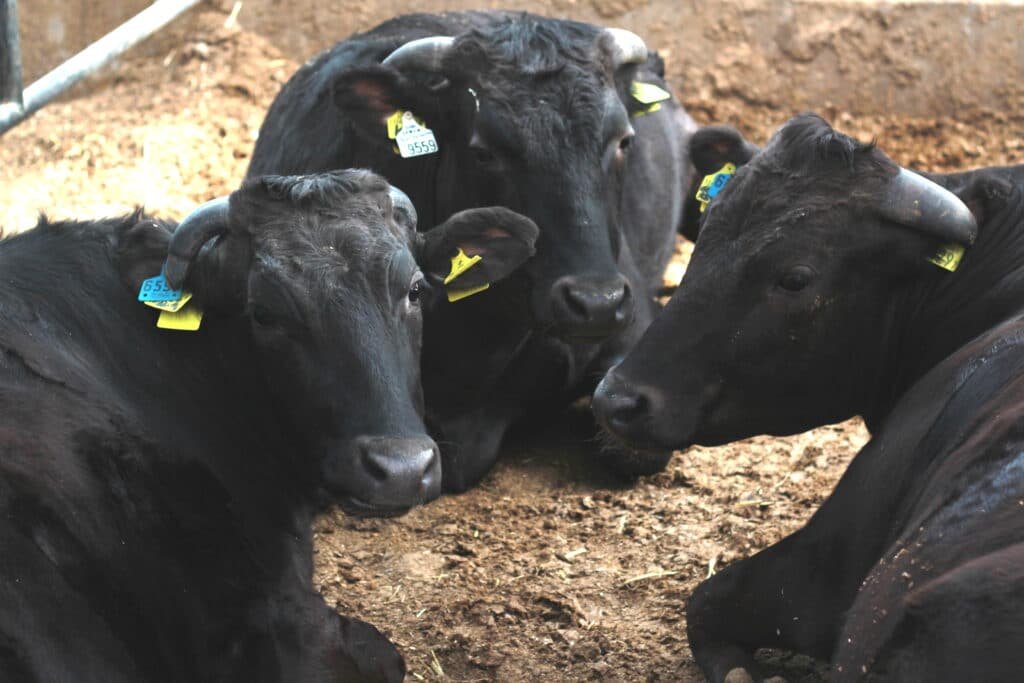
All Natural
The cattle are never given any artificial ingredients or medicine to promote growth, making it 100% natural. Although it takes more time and energy, it produce the delicious wagyu we know today. In contrary to popular belief, farmers to not tend to massage or play music to their cattle. However, they do as much as possible to allow the livestock to live in a stress-free environment. This is because stress increases adrenaline and contributes to tensed muscles and tough meat.
How is Wagyu quality ranked?
Carcasses of Japanese cattle breeds are evaluated by the Japan Meat Grading Association (JMGA). This is such an integral process in the production fo wagyu to protect integrity and authenticity. The meat between the sixth and seventh rib are graded on two specific factors: Yield and Grade. Yield is simply the ratio of meat compared to the carcass. This is based on a score by A (72%+), B (69%-72%) and C (below 69%). Grade is further separated into five factors: Beef Marbling Score (BMS), Beef Colour Standard (BCS), Beef Fat Standard (BFS), Firmness, and Texture. Each of these factors are graded from 1-5, 5 being the highest score and 1 being the lowest.
A5 is the highest quality wagyu you can get and the beef must be graded as Grade A for yield and Grade 5 in BMS, BFS, BCS, firmness and texture.
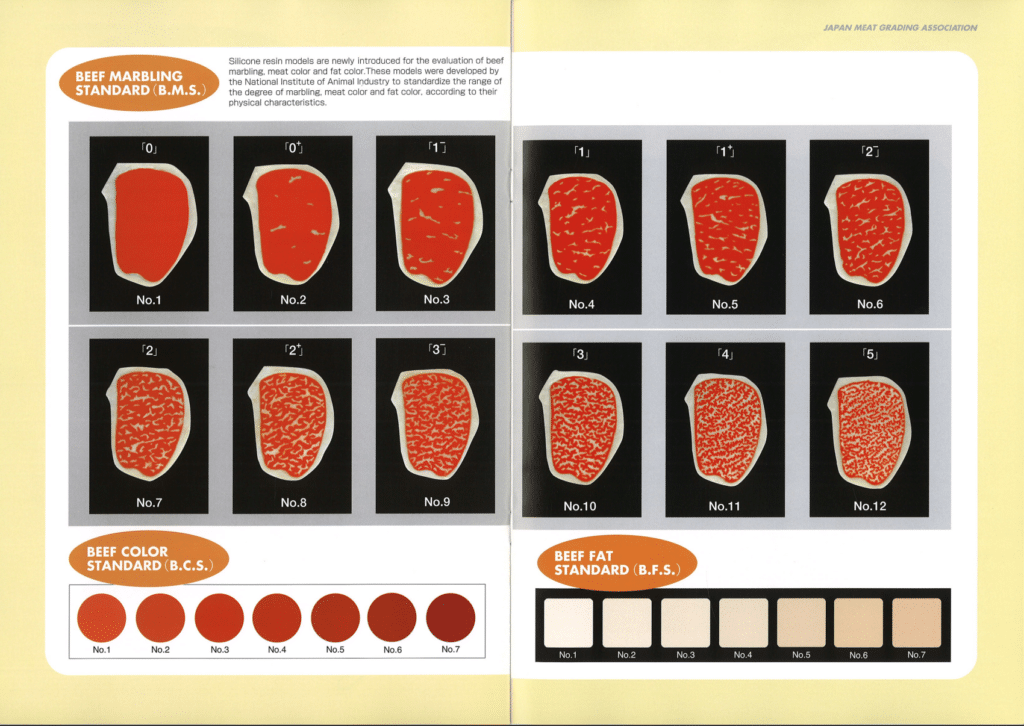
Different types of Japanese Wagyu
Kobe Beef
Kobe beef is the most internationally famous wagyu brand known worldwide. The city of Kobe was a key port for imports and exports in Japan, which allowed Japan to promote Kobe Wagyu to the rest of the world. The prestigious beef comes from the black Tajima breed of Wagyu Cattle, which has pass a strict passing of the Kobe Beef Marketing and Distribution Promotion Association.
Ohmi Beef
Ohmi beef comes from the cattle breed around Lake Biwa in Shiga Prefecture. The abundant nature around the lake lends itself for an excellent cattle raising environment. The lake’s clean water and the carefully selected feed, produces meat that is well marbled and soft, with tender fat and a mellow smell. Although Kobe is more unanimously known, Ohmi beef is considered just as, if not, better.
Matsusaka Beef
Matsusaka beef comes from a small, rural town in Mie prefecture. It is highly regarded for its flavor, richness, and distinctive marbled texture. The cows are specifically selected and then matured for 3 years giving this distinct flavour. In 2002, one Matsusaka cow sold for 50 million yen, or roughly $400,000.
Hida Beef
Hida beef comes from Gifu prefecture, jsut a little north fo Nagoya City. Prized wagyu beef from Takayama is considered some of the best beef in Japan. What sets Hida beef apart is in its muscle and marbling. This fat marblind permeates through the loin cut as well as other areas, such as the shoulder, flank and rear legs.
Miyazaki Beef
Just locates North-East of Kagoshima prefecture, Miyazaki prefecture is the second largest prefecture in producing Japanese black cattle. Much of the area is comprised of mountains and dense forests creating beautifully red-colored beef, fantastic marbling and a naturally rich flavor palate.
Hokkaido Beef
Finally is Hokkaido’s wagyu beef. The naturally cold climate, rich nature and cold air, makes it the perfect place for calves to grow. This creates a distinguished taste that is tender and juicy. Furthermore, tt contains a great deal of proteins, minerals, vitamins, iron, and other various nutrients!
Ways to enjoy Japanese Wagyu
Teppanyaki
Teppanyaki is maybe the most common way of cooking wagyu. A gas powered iron flat top allows for a variety of ingredients to be cooked. At high end restaurants, the chef will cook everything right in front of you. Typically, sliced garlic is fried to season the oil and hot plate. which is then used to cook thew wagyu. Artistically flipping and cutting, the wagyu is cooked till mouth wateringly tender and served alongside the fried garlic. Additional toppings of sea salt, wasabi and a special tare (sauce) can all be enjoyed with the wagyu.
Watch a video of wagyu being cooked teppanyaki style here!
Yakiniku
Yakiniku (translated to grilled meat) derivers from Korean cuisine. Bite size pieces of meat are grilled over a charcoal grill, or in some places, a gas grill. Various meats and various cuts of meat are available to eat, from fillets to organs. Whereas in Teppanyaki, a whole large piece of wagyu is usually cooked, in yakiniku, everything comes pre cut, allowing you to cook each piece as you would like. After grilling, you can enjoy the beef with sea salt, a special tare, or even lemon juice. In addition, you can find a wider variety of wagyu cuts and parts of the cow at a yakiniku restaurant.
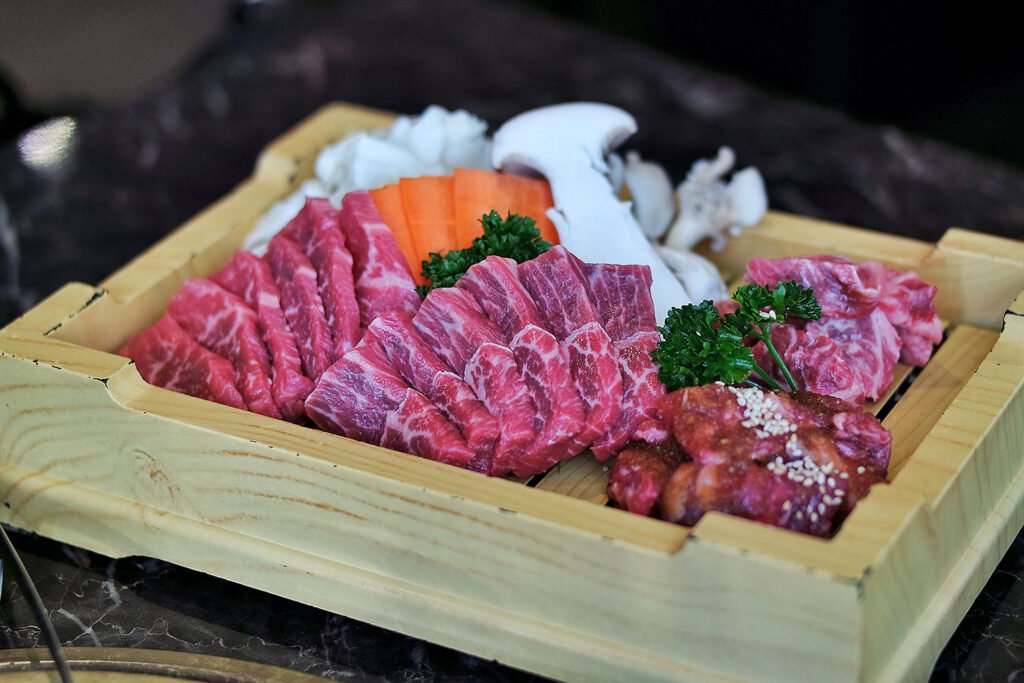
Sukiyaki
Sukiyaki is a popular hot pot dish, where a mixture of vegetables and beef are cooked in a sweet and salty soy sauce based broth. There are two variations of sukiyaki: Kansai (Osaka) and Kanto (Tokyo) style. In Kansai, the meat is first seared in the pan and seasoned with sugar, sake, and soy sauce, then the vegetables are added. In Tokyo, all the ingredients are cooked in a sukiyaki sauce. Wagyu beef is usually slice thinly and gently cooked so it becomes tender and melt in your mouth. It is common to dip the cooked ingredients in a beaten raw egg before eating.
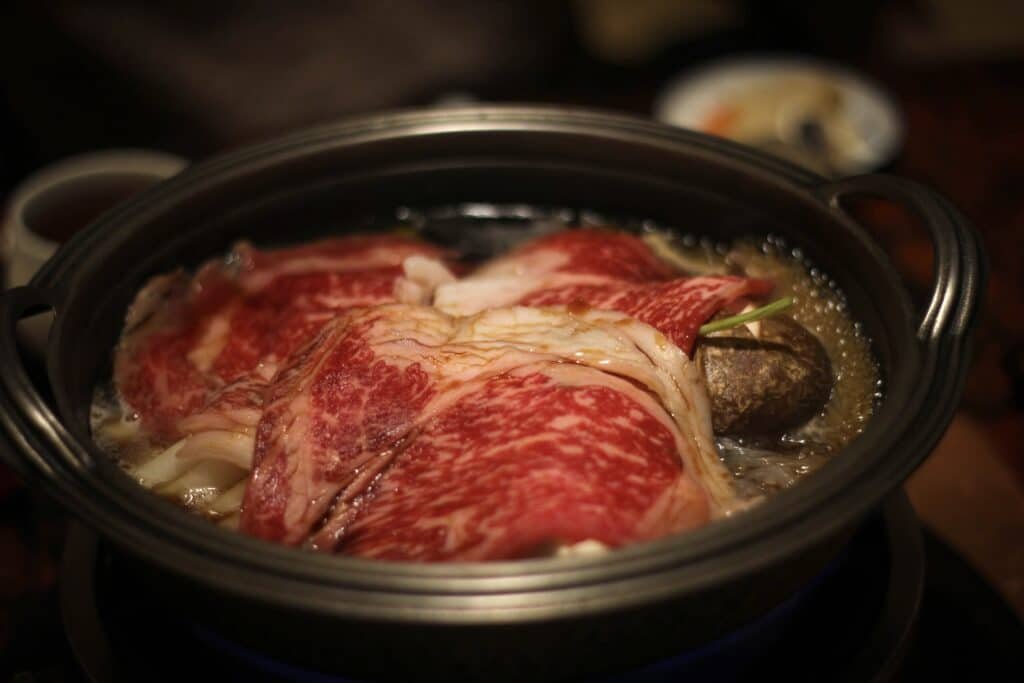
Shabu Shabu
Similar to sukiyaki, shabu shabu is also a hot pot dish. A selection of vegetables and proteins are cooked in dashi (Japanese stock) until tender. Sesame sauce and ponzu sauce are two common dippings that you can eat the ingredients with. The sounds of stirring the vegetables and meat with your chopsticks gives the onomatopoeic name ‘shabu shabu’. It’s a common dish to enjoy with friends and family that brings people closer together.
Sushi
Although sushi is commonly eaten using raw fish, that melts in your mouth, wagyu is also used for it’s same properties. The rich marbling of fat and umami packed beef makes it a perfect topping for sushi. In addition, it can be lightly blow torched, allowing that delciious fat to render and back even more delicious.
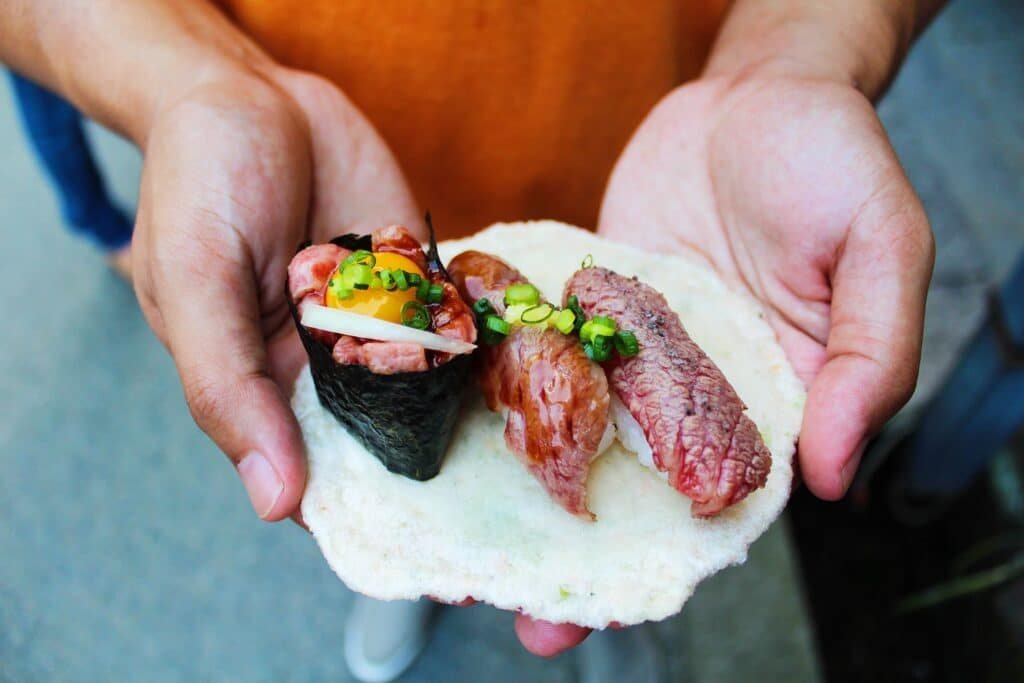
Yakitori
Small cuts of wagyu beef are skewered, lightly seasoned and grilled over a charcoal grill. The charcoal adds a smoky, barbeque flavour, whilst allowing the fat to render and become tatilisingly tender. Yakitori is a great way to eat wagyu as it is cut in bite size pieces, so you just get the right amount.
Where to enjoy Wagyu in Osaka
Matsuzakagyu Yakiniku M
Specifically serving Matsusaka Beef, this restaurants advises you to enjoy the natural taste of wagyu with simple salt or soy sauce. Matsusaka beef is raised between the Izumi and Miyagawa river in the suburban area of Matsusaka City. They take extreme care in raising their cattle, as they massage and even give beer (helps develop appetite and fat in the cattle). Specifically, they have their own staff to look after and examine each cow to ensure that the perfect wagyu is supplied to their customers.
You can enjoy various cuts of the cow that are all beautifully presented to ensure you know exacvtly what you are eating. Finally, the dark and cozy atmosphere makes it relaxing and one of the best spots in Osaka to enjoy Japanese wagyu beef.
Opening Times: 17:00 – 21:00 (Saturday and Sunday 12:00 – 15:00, 17:00 – 21:00)
Phone Number: 06-6211-2904
Website
Address: 〒542-0076 Osaka, Chuo Ward, Nanba, 1 Chome−5−24 だるまビル 2F
Kitamura
Founded in 1881, Kitamura serves Kansai style Sukiyaki, which is a favourite amongst locals. They only used domestically raised wagyu, which is full of umami and sweetness. The thinly sliced wagyu becomes tantilisingly tender with the sweet and salty broth adding a deeper depth of flavour. There are other dishes available such as mizudaki (boiled beef slices) and batayaki (beef fried in butter).
There are traditional Sukiya style rooms as well as tatami rooms with horikotatsu. These are spaces where there are gaps in the floor under the table to rest your legs. The relaxed yet refined atmosphere makes it a fantastic place to enjoy some wagyu sukiyaki style.
Opening Times: 16:00 – 22:00 (Closed on Sunday and public holidays)
Phone Number: 06-6245-4129
Website
Address: 1-16-27 Higashishinsaibashi, Chuo-ku, Osaka
Fukushige Horumon Osaka-shinmachi Branch
Located around Yotsubashi station, in a district filled with offices and shopping malls, Fukushige Horumon is crowded nearly every day. The relaxed and lively atmosphere makes it welcoming to anyone. The kitchen mainly serves A4 Wagyu from Kagoshima, with a variety of cuts available. One of the most popular cuts is the Skirt steak, which is deliciously tender. You can order the wagyu as it is or marinated in their sweet homemade sauce. The spicy dipping sauce makes it a perfect combination with the fluffy white rice. Finally, the beef tongue is sliced thickly compared to other yakiniku restaurants. The umami rich and soft yet chewy texture is a must try!
Opening Times: Lunch 11:30 am – 2:00 pm (L.O. 2:00 pm), Dinner 5:00 pm – 11:00 pm (L.O. 10:30 pm)
Phone Number: 06-6578-4880
Website
Address: 1-8-9, Shin-machi, Nishi-ku, Osaka-shi, Osaka
Sumibi Yakiniku Tsurugyu
Using Tajima beef, the prefectly marbled and sweet beef is recommended to eat rare. Their recommendation is the chuck eye, which is simply eaten with sea salt, garlic flakes, soy sauce or Japanese mustard. They have a wide selection of cuts available, including the organs and intestines of the cow. This can be enjoyed a la carte or as a course meal.
Finally, the restaurant, with its natural wood-based interior, has two tables for four, three horigotatsu tables for four and a semi-private room for six customers.
Opening Times: 17:00 – 24:00 (Closed on Mondays)
Phone Number: 050-5263-9922
Website
Address: 3 Chome-5-14 Kawarayamachi, Chuo Ward, Osaka, 542-0066
How to cook Japanese Wagyu at home
The incredible marbling of fat and natural umami rich beef should be preserved so I recommend simply frying it with salt. The amount of fat in Wagyu creates a butter like texture, which can be too rich if too much is consumed. With wagyu beef, I would always recommend medium rare but with wagyu medium is also delicious! No matter how you cook wagyu, it will be tender and juicy, however at a medium-rare cook, the fat will have time to render. The rendering process will help the meat become more tender as well helping release some of the sweet and umami flavour stored inside.
Ingredients
Wagyu Beef
Salt
Pepper
Sliced Garlic
Method
Step1
Let the beef come up to room temperature
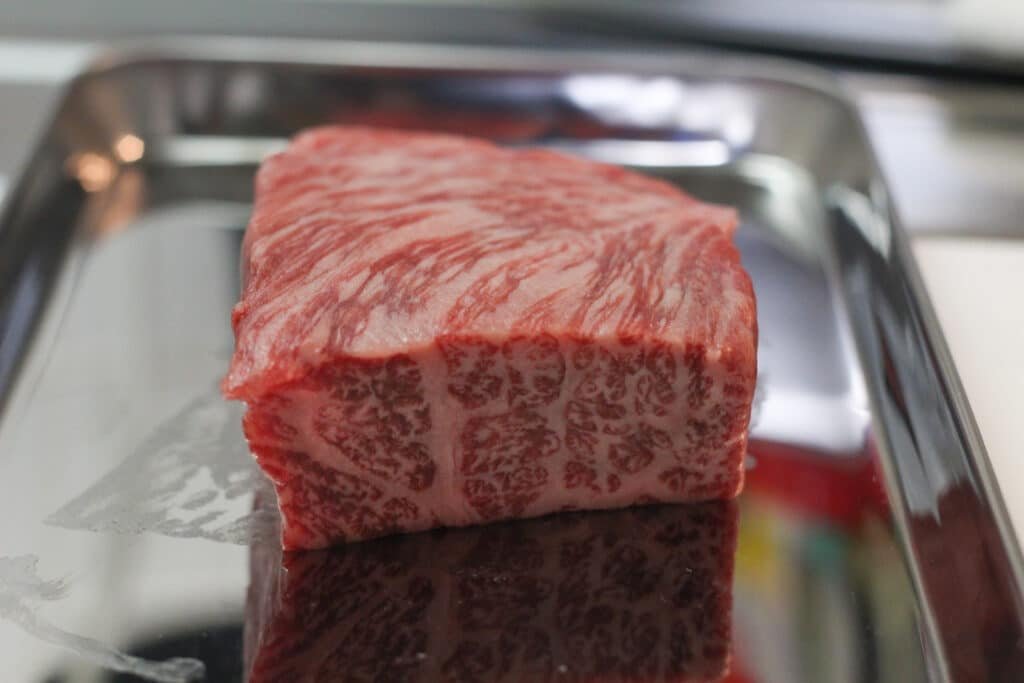
Step 2
Fry the sliced garlic in a medium hot pan. Fry until crispy. Drain the garlic on kitchen paper and set aside. Discard remaining oil (or use for another dish!)
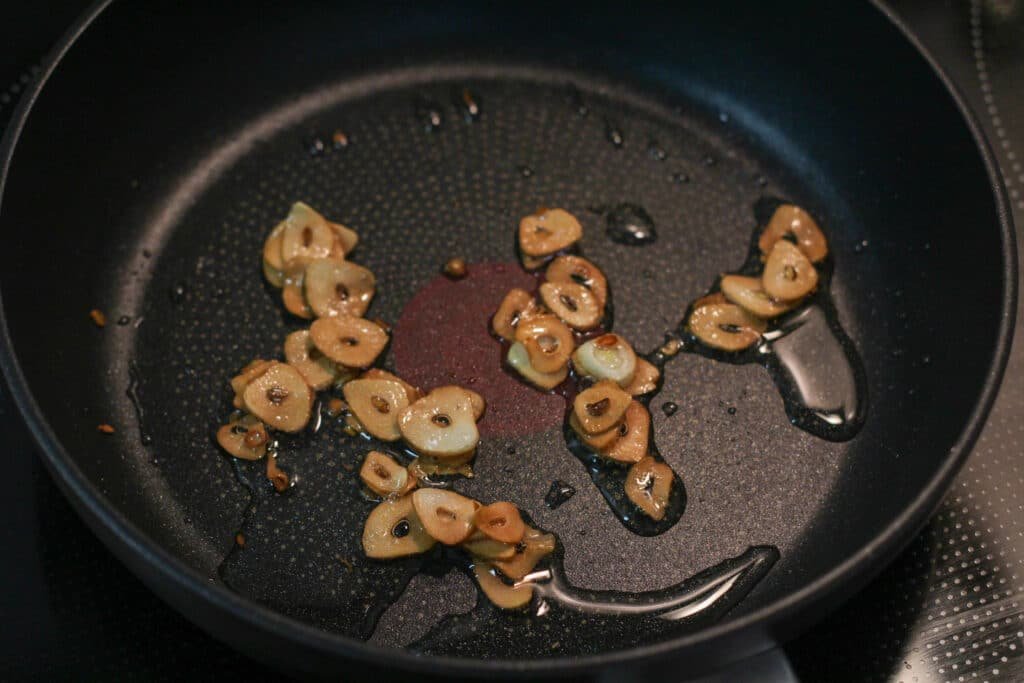
Step 3
Season the beef with salt. In a scorching hot, non-stick pan, sear the meat for 2 minutes (depending on the size). You do not need to put any oil in the pan as there is so much fat in the wagyu.
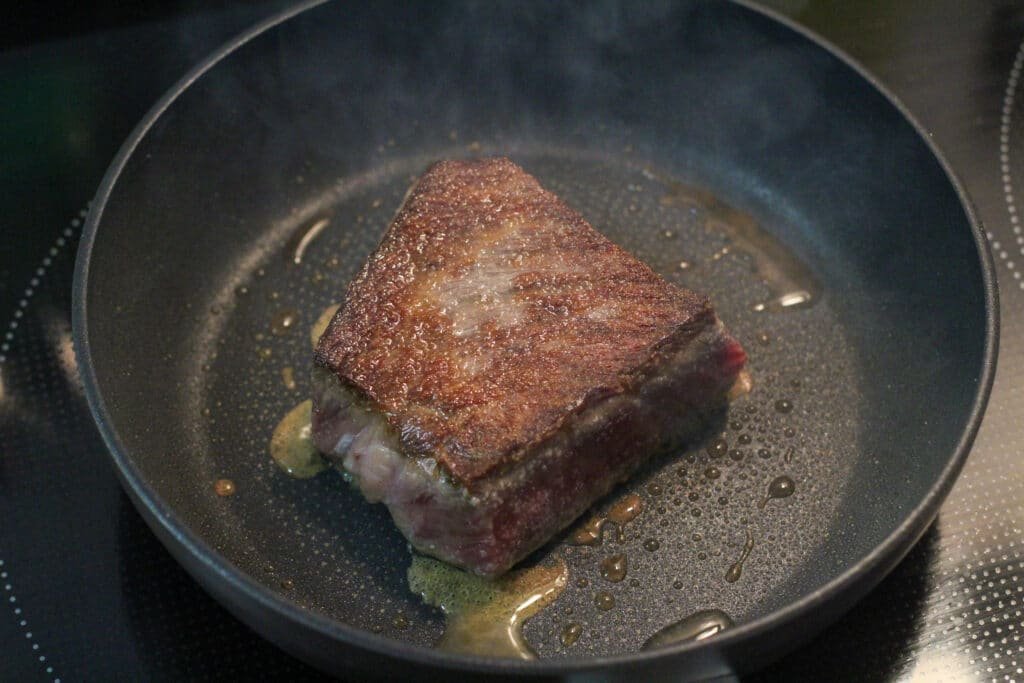
Step 4
Flip the beef over and sear for another 2 minutes and fry all the sides of the beef.
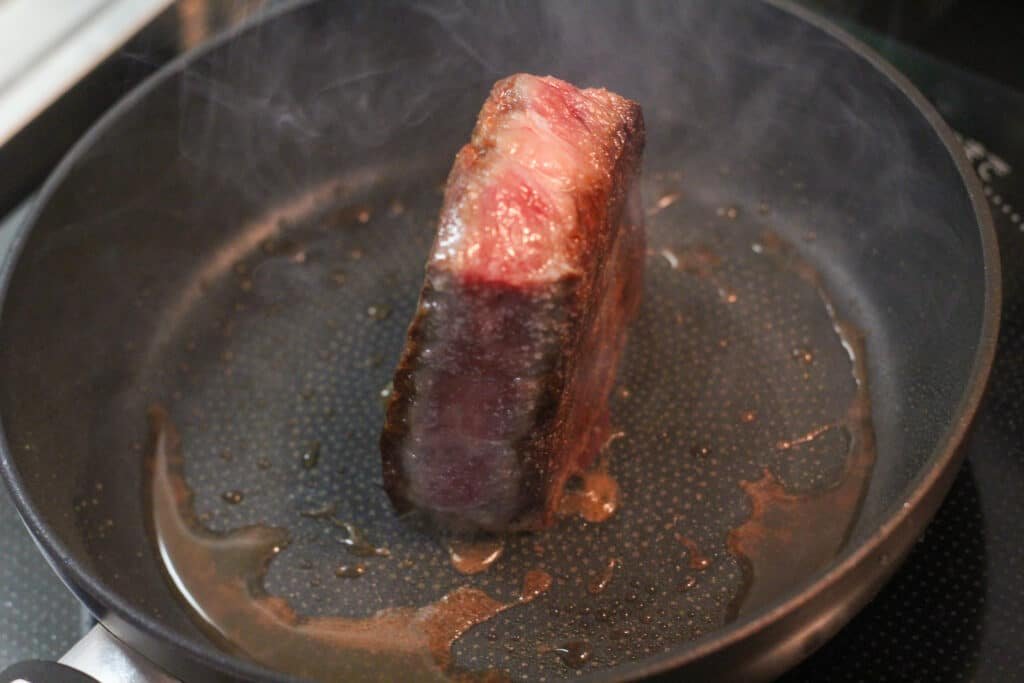
Step 5
Rest the beef for at least 3 minutes. This will help retain its juices and become even more tender.
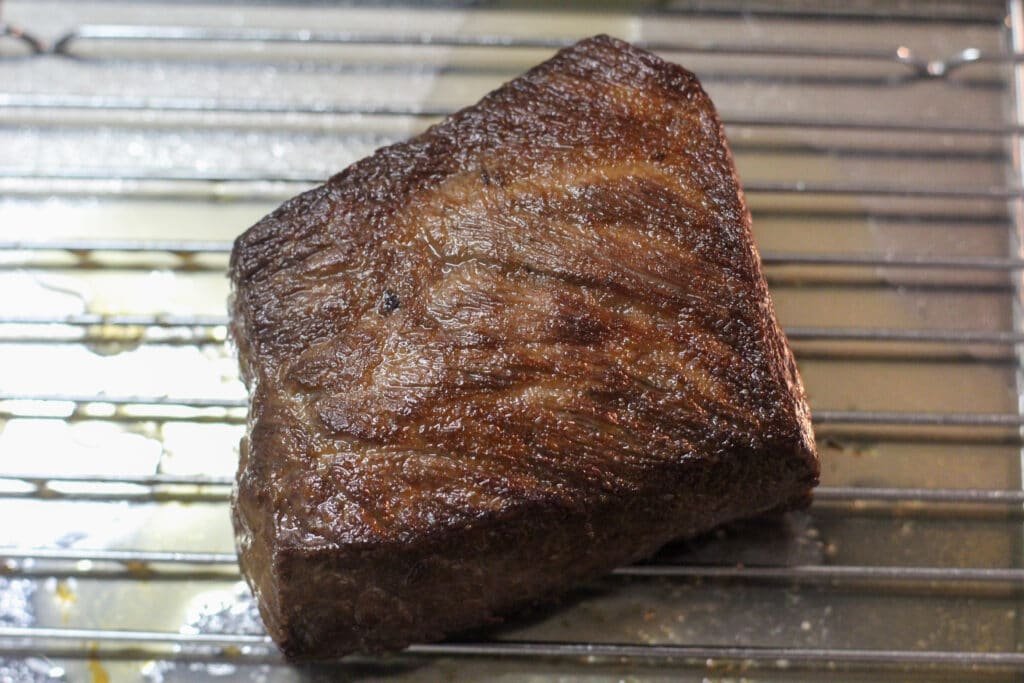
Step 6
Slice and serve with wasabi, sea salt, and the sliced garlic.
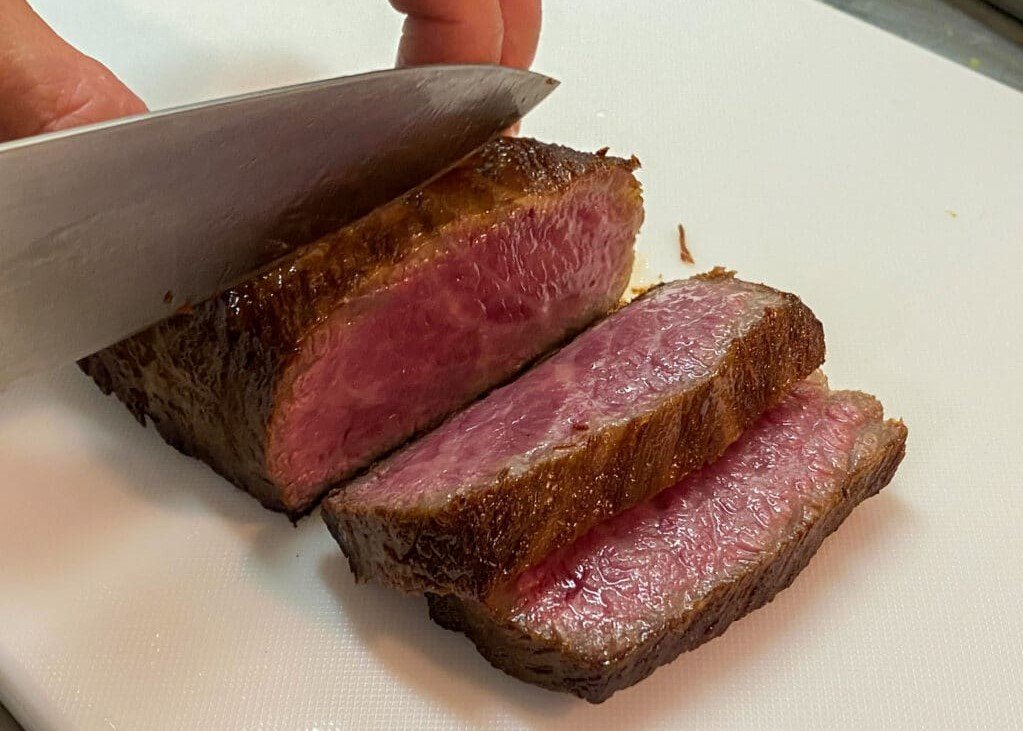
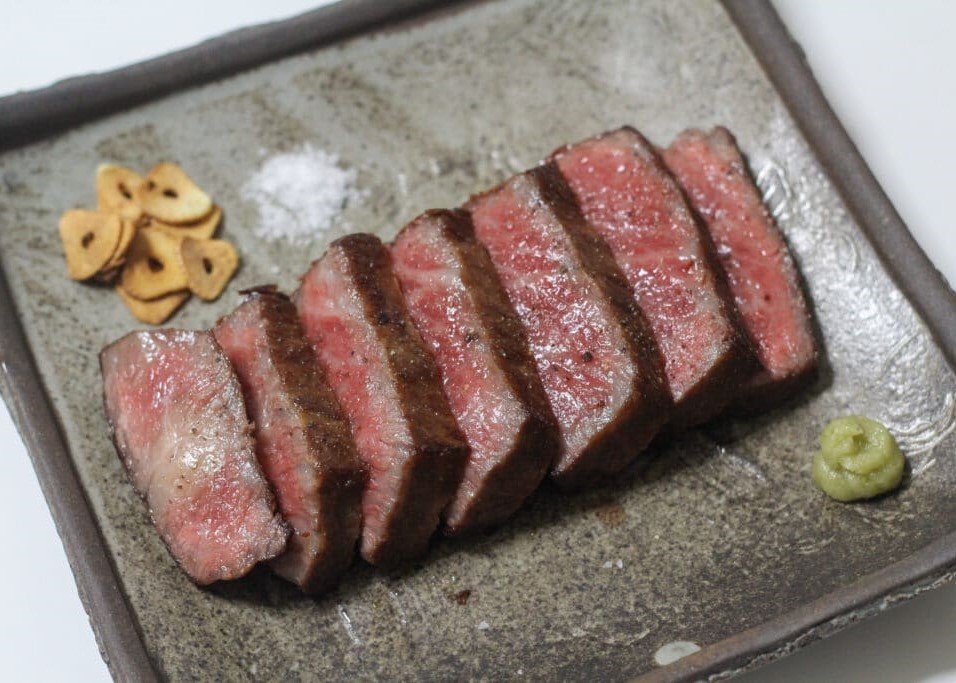
Step 7
Enjoy a variety of different combination of flavours! I recommend slicing into smaller bite size pieces to make it even more enjoyable!
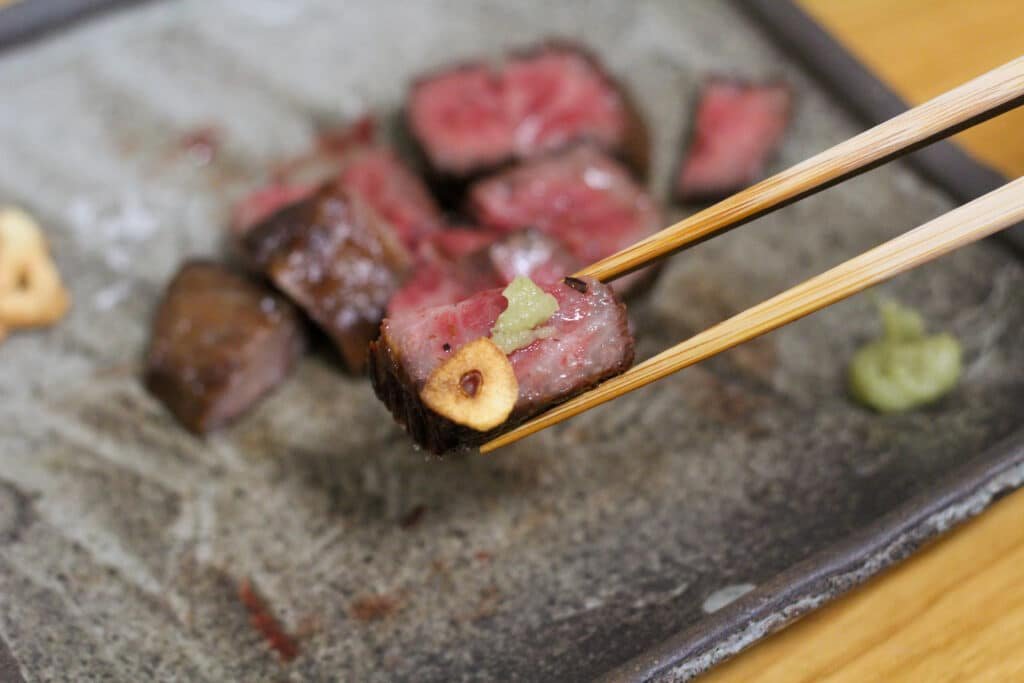
Watch a video of me cooking the wagyu beef!
Final
Japanese Wagyu beef is the ultimate meat experience. The love and care that farmers take in raising their cattle is expressed through the mouth-wateringly tender, juicy, and umami-packed wagyu. Although it’s a prized produce, the chance to experience and eat wagyu should not be missed. Teppanyaki offers all the theatrics and thrill that celebrate the famous wagyu, however there are a host of different way available to enjoy it. If you can get a hold of the 100% wagyu from Japan, it is well wroth cooking yourself just to get a taste of that sweet, umami-rich, and fatty piece of meat.

























[…] time it takes to breed the cattle is what makes it so expensive. Following strict Japanese guidelines laid out for rearing authentic Wagyu is a full-time […]